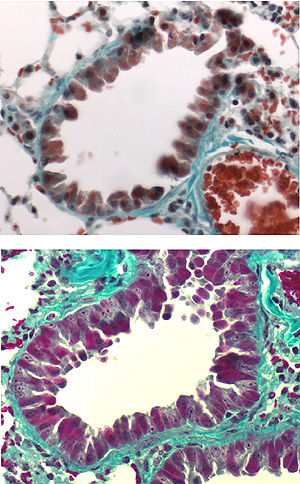Minuscule molecules pack a powerful punch

A role for a microRNA in the immune system has been shown by study of one of the world’s first microRNA knockout mouse, reported Friday 27 April in >Science. The microRNA acts as a lynchpin to balance the response of immune defences and the researchers suggest the corresponding human gene will have a similar vital role.
Cells of the immune system in the knockout mice do not work as well as normal cells and the mice develop symptoms similar to those of human autoimmune disease. They are also less able to resist infection by bacteria, such as Salmonella. The team suggest that the equivalent human microRNA will play a major role in the human immune system.
MicroRNAs are copied from DNA but do not contain code for protein. Rather, they are themselves active in controlling the activity of other genes, often by inducing destruction of protein-coding messenger RNAs or by preventing their activity in the cell.
The research team, led by the Wellcome Trust Sanger Institute, targeted a gene called Bic/microRNA-155 (or miR-155) in embryonic stem cells which they used to transfer the mutation into mice. Previous research showed that miR-155 was active in cells of the immune system and overactivity was found in lymphoma development.
“Very little is known about the function of the hundreds of microRNA genes. Although plentiful, this class of genes had never before been knocked out in mice, the best model organism for human disease.
“But we simply did not know whether microRNA knockouts would have an effect in mice: previous knockout studies in nematode worms suggested that most microRNAs were not essential. Our findings were dramatically different.”
Dr Antony Rodriguez Lead author on the paper from the Wellcome Trust Sanger Institute
The effects of the miR-155 knockout swept across the immune system. The team showed that, although knockout of miR-155 did not appear to affect normal growth and development of cells in the immune system, each major cell type – T-cells, B-cells and dendritic cells – performed less well.
“These findings demonstrate the importance of this level of control in the immune system and will lead immunologists to rethink how the immune system works.”
Dr Martin Turner Head of the Laboratory of Lymphocyte Signalling and Development at the Babraham Institute

The deficits in response were significant: the knockout mice were less able to resist infection by bacteria than mice with normal miR-155, producing lower levels of antibody and a reduced response by T-cells. They also develop changes to lung tissue, with scarring that is similar to some human systemic autoimmune disorders.
To uncover how miR-155 might cause such widespread disruption of the immune system, the team used genomic studies to identify protein genes whose activity was controlled by miR-155 in T-cells. Activity of more than 150 genes, with a large range of biological functions, was reduced by miR-155, demonstrating its role in the immune system. The team showed that a particularly important gene, c- Maf, which is critical for function of populations of T-cells, is a target for the action of miR-155.
The consequences of removal of active miR-155 are altered activation of other genes, failure to mount an effective immune response, susceptibility to autoimmunity and susceptibility to infection.
“This dramatic finding reflects a large amount of work by collaborating groups. Showing that knocking out a microRNA has such dramatic effects opens new doors to understanding this novel class of gene regulation, with consequences for human health and disease.
“Our work builds upon the sequences of the human and mouse genomes, the power of computer analysis and microarray work and exemplifies why whole-organism research can bring understanding that cannot be developed in any other way.”
Professor Allan Bradley Director of the Wellcome Trust Sanger Institute
The study emphasizes the value of the ES cell-based knockout technology, currently being pursued on a large scale through the KOMP and EUCOMM programmes at the Wellcome Trust Sanger Institute. This success illustrates the power of the mouse to reveal function and indicates a wider role for microRNAs in animals with large genomes.
More information
MicroRNAs and BIC
MicroRNAs (also known as siRNAs – short, interfering RNAs) are short (22-25 base) sequences that do not code for protein, but can lead to destruction of other RNA molecules or can interfere with their translation. They bind to corresponding bases in the target RNA. The mature microRNAs are derived from larger precursor molecules.
Bic is a non-coding RNA, around 1600 bases in length, which was identified in 1997 as a cancer-causing gene (oncogene) in chickens. The human and mouse versions were discovered in 2001. The BIC gene is activated in cells of the human and mouse immune system and in B-cell lymphomas and some solid tumours.
miR-155 is derived from within the Bic gene and is 65 bases in length: its mature form is 22 bases long. The human equivalent of miR-155 is found on chromosome 21: the mouse and human mature forms of miR-155 differ at one position. To date, some 377 microRNAs have been found in the mouse genome and 474 in the human.
MicroRNAs are being examined as possible therapeutic agents in a range of diseases. Trials are underway for macular degeneration (eye disease), chronic myeloid leukaemia and preeclampsia.
Fire and Mello shared the Nobel Prize for Physiology or Medicine in 2006 for RNAi, which led to discovery of mechanism of action of miRNAs.
Participating Centres
- Wellcome Trust Sanger Institute, Hinxton, Cambridge, UK
- The Babraham Institute, Babraham, Cambridge, UK
- Department of Pathology, Addenbrooke’s Hospital, Cambridge, UK
- Gurdon Institute, University of Cambridge, Cambridge, UK
Publications:
Selected websites
The Babraham Institute
The Babraham Institute is a charitable organisation devoted to biomedical research which is sponsored by the Biotechnology and Biological Sciences Research Council. The Institute’s research is focused on understanding the biological events that underlie the normal functions of cells and on how their failure or abnormality may lead to disease. As such, Institute scientists are striving to find cures for conditions where there is currently no treatment or where the existing treatment is not fully effective or causes serious side effects. The latest technologies are being used to study the basis of conditions such as rheumatoid arthritis, Alzheimer’s, foetal abnormality and cancer. The commercialisation of the Institute’s research is managed by its wholly-owned trading subsidiary, Babraham Bioscience Technologies (BBT) Ltd. Babraham Research Campus is located six miles south-east of Cambridge.
The Wellcome Trust/Cancer Research UK Gurdon Institute
The Wellcome Trust/Cancer Research UK Gurdon Institute is part of Cambridge University. Funding from our two main sponsors, and other sources, supports research into the complementary areas of Cancer and Developmental Biology.
The Wellcome Trust Sanger Institute
The Wellcome Trust Sanger Institute, which receives the majority of its funding from the Wellcome Trust, was founded in 1992. The Institute is responsible for the completion of the sequence of approximately one-third of the human genome as well as genomes of model organisms and more than 90 pathogen genomes. In October 2006, new funding was awarded by the Wellcome Trust to exploit the wealth of genome data now available to answer important questions about health and disease.
The Wellcome Trust
The Wellcome Trust is the largest charity in the UK. It funds innovative biomedical research, in the UK and internationally, spending around £500 million each year to support the brightest scientists with the best ideas. The Wellcome Trust supports public debate about biomedical research and its impact on health and wellbeing.


